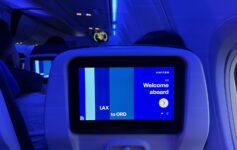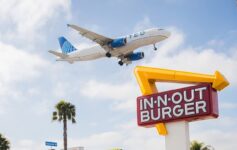
United Airlines held its Q3 earnings call yesterday in which various executives offered statements about United’s performance and fielded questions from analysts. I found the discussion over why United Airlines’ domestic yields are trending in the opposite direction of budget carriers like Spirit and Frontier the most interesting part of the discussion. The growth of basic economy at United Airlines is startling but helps to explain why.
As Budget Carriers Lose Money, United Airlines Sees Profits And Huge Growth In Basic Economy. Why?
During the earnings call, CEO Scott Kirby boasted, “United’s diverse revenue streams have also allowed us to handle variations in demand and produce solid, absolute, and even better relative results.” Notably, United and Delta combined to count for 98% of revenue growth and 90% of pre-tax profit in the third quarter. This was further emphasized by Chief Commercial Officer Andrew Nocella and comes with the backdrop of carriers like Frontier Airlines reporting major loses.
Over and over the point was made that “diversified revenue streams” are contributing to increased profitability. To that end, United is targeting more growth not just in premium seating, but in basic economy:
- Basic economy now accounts for 12% of United’s domestic passengers
- United expects to be “even more competitive in this segment of the market in the future with the arrival of our large narrowbody jets in 2024 and 2025.”
- Basic economy revenue was up 50% year-over-year in the third quarter
In short, United’s formula of appealing to a wider customer base that may fly United (from budget travelers to those wanting a premium product) seems to be working well. When United can match the pricing of Spirit Airlines or Frontier but include so much more in the package (particularly in terms of the in-flight soft product), customers are choosing United. Customers who are flying internationally or prefer a premium product are also choosing United.
Nocella further explained United is out-performing budget carriers due to:
- The shrinking cost gap between legacy carriers and budget carriers thanks to United’s growing gauge (larger airplanes) on domestic routes
- Market saturation on low-margin routes
- “There are only so many seats Florida, Cancun or Vegas can support in such a short period of time.”
- United’s diverse product offering, creating “a structural advantage that generates revenues more than the cost it creates by the complexity and just cannot be replicated.”
- United’s domestic capacity growth aimed at “correcting a gauge mismatch created by the overuse of high-cost passenger unfriendly single-class regional jets.”
Nocella’s full answer is below, which is highly detailed and quite interesting:
There’s a large range of business models today that didn’t exist in years past in this business. And these models are clearly creating winners and losers in a way many of us did not anticipate during the pandemic. I recall telling all of you on the Q1 2022 call that industry domestic margins will be challenging post-pandemic.
Clearly, the thinking at the time was — for most, at least, was that all airlines would be pressured equally at best and the legacy carriers even more so, right? It was widely assumed that lower margin, higher cost legacy carriers, which shrink rebalance in supply and demand, an outcome that has happened so many times in the past, so why not again? The number of times I heard that the airline with the lowest cost wins the race, I can’t even begin to count. So, that kind of sets up what about the business models has shifted so much to cause this paradigm change we’re seeing today.
Why are these low-cost airlines so unprofitable? Why does United have top tier results? And first, I just want to be really clear. United’s domestic network is profitable. So it’s not simply our great global network that’s creating this outcome for us. The first issue, of course, Mike talked about it is cost. Every airline has to manage higher inflationary cost pressures with the lowest cost carriers’ cost structure relative to the legacy carriers are clearly converging. The shrinking cost gap is just a fundamental shift for United and our industry. And I guess, I would rank that number one.
You said it’s impossible to run your airline like it’s 2019. High utilization was a critical ingredient for success of certain models, and that’s simply not possible, where we are today. And also having large labor cost differentials are not possible. Low-cost carriers also tend to operate at a very high gauge already. It will be much more difficult for them to drive cost materially lower with larger gauge planes like United. United has increased domestic gauge more than any airline since 2019, and our plan is to push that even further in the years to come.
Another issue that I think we should talk about is it’s difficult for many to grasp is not every ASM is created equal. It’s easy to mistake often in the middle of really large spreadsheets that everyone uses to evaluate our outlook, right? At United, we proved this point early in 2018 and ‘19 with our growth and revenue performance and we just did it again in Q3.
Market saturation of the low-cost business model in certain regions is creating very low marginal RASMs for some of our competitors. In fact, many of our competitors have marginal revenue percentages that are negative. There are only so many seats Florida, Cancun or Vegas can support in such a short period of time. Also low-cost carriers generally must operate a very large gauge equipment to have low-cost without the connectivity benefit of the hub-and-spoke business model, expansion of the low-cost model into smaller and medium-sized markets with these very large jets lacking connectivity just creates low marginal RASMs.
Market saturation and the mismatch of gauge and other connectivity continues to plague certain business models. Expansion opportunities with this type of business model are not endless in our view, but in response to that shortcoming, many of our domestic competitors have doubled down with plans for even more growth in 2024. 2024 marginal growth in markets will absolutely be no better than 2023. No airline network team would say, let’s add the bad markets in 2023, so we can save the good ones for 2024.
The other factor is the percentage of ASMs that these airlines have in new markets. Very fast growth rates simply create a high percentage of new capacity, which by its nature in the best of times is below average. The fourth quarter — this fourth quarter, United has less than 1% of our ASMs in new markets versus ‘19. This is an absolute difference maker. And capacity growth is designed as a strategy to maintain low cost without revenue accretive markets to add the entire business model can break. And that is what we think is happening right now.
United’s domestic capacity growth has always been about correcting a gauge mismatch created by the overuse of high-cost passenger unfriendly single-class regional jets. At United, we have this diversity of revenue streams that provide us long-term stability and earnings that a one-dimensional plan will never achieve. We have a range of products, including array of premium seating options that’s increasingly popular with our travelers.
We fly as much capacity in global markets as we do domestically. We fly to big cities and small. We have a great hub-and-spoke business model. United has significant margin accretive growth, and we’ve proven that time and time again. United’s business model can support dramatically higher gauge and once added, we spill less and less traffic to others. United’s higher gauge will create more and more cost conversions between now and 2027. The complexity of United’s product offering is not a disadvantage. It, in fact, is a structural advantage that generates revenues more than the cost it creates by the complexity and just cannot be replicated.
In the past, United and other legacy carriers that have emerged from the crisis smaller, creating excess planes and other resources for others to grow. This time, that will not happen. This time around, it is not United with the low margins. We will not adjust our plans. United’s focus on global markets has clearly won the day in Q3, and you can see that in the results. Our focus on domestic gauge is absolutely the right one. We’ll no longer spill as much revenue to others as we’ve done in the past. Our focus on basic fares means we’ll be able to be even more competitive.
United will moderate our domestic growth plan, as I said earlier, for the first half of 2024 because we’re focused on building our Asia Pacific line where we see the strongest short-term results. But I have to say, maybe in our timing, there may be off to a few other — the timing may be off, Jamie, but the quarters are coming, and there’s a lot of other variables. And I truly am confident that sooner or later, the industry will rebalance like it has done in the past, and the United and a few others with similar diversified revenue streams are going to come out on top.
In a sense, Untied is being “all things to all customers” in the routes and products its offers.
CONCLUSION
United attributes its strong relative performance to budget carriers due in large part to the “diverse revenue streams” it offers ranging from basic economy to Polaris business class. But the explosive growth of basic economy is an interesting development and helps to explain why United appears to be poaching business from the budget carriers and now reporting a much rosier outlook.




The ‘customer unfriendly single-class regional jets’ weren’t “high-cost” before. But with the pilot shortage and wage growth pressure, all of a sudden they became “high-cost” and a drag on earnings.
More importantly, all those little spoke markets that UA left (30-some so far??) are NOT coming back.
Which Nocella made clear here:
https://liveandletsfly.com/united-airlines-domestic-network/
Hopefully they will start investing some of these profits into a better on board product.
Lol we know they won’t…
Huh? They are.
They’ve made a pretty vocal commitment to do so and are executing on it. Not sure what you’re talking about. They’re adding in-seat video on all domestic flights, new seats, blue tooth audio capability, etc. What are you looking for?
What are you talking about, Aaron? You haven’t seen the reconfigurations they’re doing to the domestic fleet to add, among other things, larger bins and seatback screens?
I’m talking about things like the service and the food. Especially for international travel.
If you want great service and food internationally, why would you fly a US carrier? If you want *A, transatlantic would be Austrian or Swiss, and transpacific would be ANA or Singapore. UA will never provide the level of soft products as those carriers.
Sometimes its the only (or most cost effective) option.
Soft product is important to me. If Polaris was the cheapest option, I’d still be willing to fly it, but I’ve never seen it cheap. That’s why I haven’t flown it since a year before the pandemic.
What exactly are you prattling on about? I flew a 3h45m midcon with UA last week and was surprised and impressed at the FIVE meal choices in First Class. All of them looked decent to tasty. In contrast, you have AA’s 2-3 (usually inedible) choices or DLs marginally better ones. The services is leagues better than AA, and on par with DL.
@ Matthew — Where’s Mr. Dumb? Surely you don’t understand airline financials as much as he. Stay tuned for him to tell you why…
If someone flies a domestic leg to connect to an international one I wonder if they consider the domestic flight as falling into that route network?
It’s an interesting question because we’ve seen this year that the pent up travel demand seems to have shifted from domestic and more “local” international markets to those that are long haul like Europe. Obviously United wit their strong international route network is benefiting from this trend. It will be interesting to see how much that continues.
I also hope from a purely selfish point of view that United continues to invest in a better across the board on board product and a loyalty program that makes it worth while for non million milers to be a part of.
That last part is an aspect that I feel very few if any airlines seem to get right now. The loyalists will spend their money no matter what. It’s the marginal traffic that might go free agent that you want your loyalty program to go after. That loyalty program should be good enough that I’m willing to pay a premium to fly on United because there is a return on that investment.
Passenger are fed up with low level service on board low cost carriers, crammed seating, no seat back entertainment and bob. Attitudes change and keeping up with passengers attitudes increases your bottom line and also leads to loyalty. Comfortable seating, onboard entertainment and quality food and beverages will attract passenger who are willing to pay more. Increased flight availability is helpful too.
“Basic economy now accounts for 12% of United’s domestic passengers”
Can this be a correct number? It seems very low.
I think it is right considering that basic economy is often not an option in many international and domestic markets.
I almost never fly United. The fares are usually unreasonable out of STL and requiring economy passengers to check in to inspect bags for compliance with restrictions (no electronic boarding pass) is irritating. That said, I found a rare deal from STL to HOU and used that as a springboard to Spirit, big front seat to Guatemala. Worked out quite well. Everyone I interacted with on and off the plane was very friendly and helpful.
I could have just flown Delta the whole way since I’m Medallion + Amex Reserve but I was tagging along with a friend who speaks Spanish.
Anyway, United isn’t that bad.
Right here with ya (also a St Louis guy originally from Detroit). United and their CRJ 550 are neat planes, but from the Lou always way too expensive compared to other options.
Mostly a southwest city at this point anyway.
United basic was a great deal for us. $240RT DCA-PHX with a checked bag because I used a branded credit card for $100/year fee. For a family of 3, even a single RT flight comes out to a net $100 savings with the branded card. Spirit doesn’t offer these “outs”. In addition to that, like the joke goes that you get to your destination in economy as quickly as first class does, United is more reliable than Spirit.
As Kevin O’Leary points out on Shark Tank: If a small business has some system that’s not unique, there’s no reason for a big company to not “stomp on them like the cockroach they are”.
Ironically, this may make Spirit cheaper for JetBlue to acquire but I’d hate to see Jetblue ruined because it’s our preferred carrier for domestic runs.
Also playing out here is most ULCC customers are cost/budget focused and I suspect their discretionary income has been massively pressured by inflation the past 2-3 years and/or the ability to keep running up credit card debt to cover T&E spending.